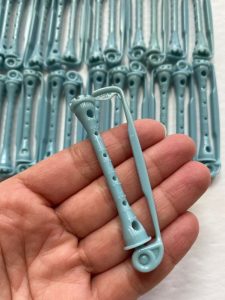
Understanding the Perming Process Using Perm Rods
Perm rods play a central role in the perming process, which involves chemically altering the hair’s structure to achieve long-lasting curls or waves. The steps are straightforward but require precision:
- Preparation: The hair is washed and treated with a perm solution, which breaks down the natural structure of the hair.
- Rolling: Hair sections are tightly wrapped around perm rods. The diameter of the rod determines the size of the curl—smaller rods create tighter curls, while larger rods result in looser waves.
- Processing: A chemical solution is applied to the wrapped hair to lock in the new curl pattern.
- Neutralizing: Once the desired curl has set, a neutralizer is applied to restore the hair’s structure and seal in the style.
Diverse Perm Rods: Options for Different Curl Patterns
Perm rods come in various sizes to achieve a range of curl styles:
- Small rods produce tight, defined curls.
- Medium rods create soft, flexible waves.
- Large rods generate loose, beachy waves that are more relaxed.
This versatility makes perm rods suitable for all hair types, from fine to thick, and allows for a wide variety of styles.
Perm Rods at Home: The DIY Revolution
While salons have always been the primary location for perms, the 1970s and 1980s saw the rise of at-home perm kits. These kits included perm rods, chemical solutions, and step-by-step instructions, making it easy for anyone to attempt a perm in the comfort of their own home. Perming at home became an affordable alternative to expensive salon visits, democratizing access to trendy hairstyles.
The Cultural Legacy of Vintage Perm Rods
Vintage perm rods offer a glimpse into a bygone era of hairstyling. Their design reflects not only the fashion of their time but also the technological advances that made perms more accessible. These rods were instrumental in helping women (and men) achieve the fashionable curls and waves that defined modern beauty in the mid-20th century. They evoke a sense of nostalgia for a time when perms were synonymous with high fashion and sophisticated style.
Modern-Day Influence of Perm Rods
Although perms have waned in popularity since their peak in the 1980s and 1990s, the legacy of perm rods endures in modern hairstyling. Today, hairstylists often draw inspiration from vintage looks, using perm rods to recreate retro styles or add a touch of nostalgia to modern trends. Whether it’s a nod to classic curls or a creative blend of old and new techniques, perm rods continue to be appreciated for their role in hairstyling history.
A Collector’s Dream: The Appeal of Vintage Perm Rods
Vintage beauty tools, including perm rods, have become sought-after collectibles for beauty enthusiasts and collectors alike. These items can be found in beauty museums, retro-themed salons, and private collections. As hairstyling technology has evolved, vintage perm rods now serve as a testament to the creative and cultural significance of beauty practices from the past.
A Return to Classic Curls: Perms in the Present Day
Recently, there has been a resurgence of interest in perming, driven by a desire for classic, timeless hairstyles. With the growing trend of blending vintage and modern beauty techniques, some hairstylists are revisiting traditional perming methods, including the use of perm rods, to create authentic retro looks. This revival highlights the lasting appeal of the perm and its iconic styling tools.
Conclusion
Vintage perm rods are more than just hair tools; they represent an era of innovation and cultural significance in hairstyling. Their influence is still felt today in the way we approach beauty and hair trends. Whether cherished as collectibles, used in modern styling, or admired for their role in beauty history, perm rods offer a fascinating glimpse into the evolution of hairstyling techniques over the years. Their legacy as cultural artifacts remains as enduring as the curls they once helped create.